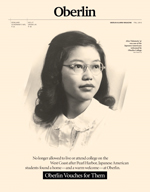Oberlin Alumni Magazine
Winter 2014 Vol. 109 No. 1
Obereactions

Notes on Camp
As a Sansei (third generation Japanese American), “Oberlin Vouches for Them” (Fall 2013) touched me to the core. My family, as well as others on the West Coast, was sent to internment camps during WWII. I recall my father’s pride when I graduated from the University of California, Berkeley, something he was prevented from doing due to the evacuation. It is the same pride and gratitude I will feel when my son graduates from Oberlin College this spring. It is my hope that he will live up to the traditions of scholarship, character, and humanity, which are the traditions of Oberlin.
Susan Nishi Stevens Bow, N.H.
My husband is a 2003 Oberlin grad, and we both read the magazine. My thanks to Lisa Chiu, Clyde Owan, Kenneth Grossi, Cassandra Guevara, and the rest of the magazine staff for your feature story. I was deeply moved by the stories of Alice Takemoto, Kenji Okuda, Dave Okada, and their colleagues, as well as the ongoing work to educate younger generations. We should never forget how easy it was for seemingly rational Americans to justify a grave civil and human rights violation in the name of national security. I am glad to know that Oberlin saw through these discriminatory and racist policies for what they were.
Katherine Yun (Princeton ’00) Philadelphia, Pa.
Thank you for the wonderful article. My grandfather was interned at Minidoka. I’m not surprised that Oberlin opened its doors to Japanese American students during a time when it would have been easy to give in to racial prejudice and unfounded fears. Oberlin’s commitment to access, diversity, and inclusion is one reason I was drawn to it. For Bay-area readers interested in learning more about the internment, I recommend visiting the Japanese American Museum of San Jose.
Kay Kusuda Zimmer ’78 San Jose, Calif.
Your readers might be interested in reading the definitive book about the national experiences of such students nationwide. Allan W. Austin’s From Concentration Camp to Campus (Urbana, 2004) tells that story and includes several references to Oberlin. Many elite institutions have less than creditable history on that score.
Roger Daniels Hobart, Wash. The author is the Charles Phelps Taft Professor Emeritus of History at the University of Cincinnati.
The cover feature stirred some vivid memories for me. I was a “townie” during WWII, as my dad, Vince Hart Sr., was the investment executive at the college during those years. We were living in a large house known then as The Pines, so we had lots of room for guests. Especially during the war years, my parents made a practice of inviting students from far away to be our guests during the Christmas holidays and at other times. A number of important friendships were formed that way, especially with students from overseas. The story of displaced Japanese American students brought to mind one displaced person in particular. Anna Edwards was a Philippine American, her father an American missionary. The family was trapped by the Japanese occupation of the southern island where her father had been doing work. His nationality put them at even greater risk than the native population. Anna and one or more siblings were spirited out of the country under cover of darkness to a submarine that took them to Australia. I believe she was still of high-school age at the time. After a year of living further east in the U.S., Anna came to Oberlin and into what proved a lifelong relationship with our family. It would be interesting if someone would search out the stories of what must have been other Oberlin students who arrived during WWII as persons displaced from places around the world.
Vince Hart Jr. ’53 Tacoma, Wash.
Deepest thanks for your research into the college’s active role in offering a hospitable academic environment to Japanese American students. I recall Professor Ron DiCenzo referencing this once in a class, but I had not realized how concerted an effort the school had made, nor had I known that the student body elected Kenji Okuda president of the student body. I’m grateful to learn of this proud moment in Oberlin’s history.
Sophie Richardson ’92 Takoma Park, Md.
Peaking
I climbed the highest points of the lower 48 states during my 60s (“Staying in the Game,” Summer 2013). My athletic activity while at Oberlin was limited to modern dance. I am still hiking/climbing. My new goal: high points of the counties in Nevada. John Erikson was a classmate of mine.
Squeek Steele La Vake ’61 Virginia City, Nev.
Sigel Catalog
It’s great that you featured Carl McDaniel’s book Trail Magic and mentioned his forthcoming book At the Mercy of Nature. However, I was disappointed that you did not mention where people can find those books (www.sigelpress.com), and that his publisher is an Oberlin College alumnus.
Thomas Sigel ’86 Medina, Ohio
Oberlin Alumni Magazine welcomes comments from readers. Please address your letters to:
Oberlin Alumni Magazine 247 W. Lorain St. Suite C, Oberlin, OH 44074-1089
Or e-mail: alum.mag@oberlin.edu.
Letters may be edited for clarity and space.

Want to Respond?
Send us a letter-to-the-editor or leave a comment below. The comments section is to encourage lively discourse. Feel free to be spirited, but don't be abusive. The Oberlin Alumni Magazine reserves the right to delete posts it deems inappropriate.